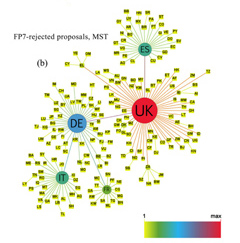Accueil
All-optical production and trapping of metastable noble gas atoms down to the single atom regime (Vol. 46 No. 1)

The determination of isotope ratios of noble gases has many applications e.g. in physics, nuclear arms control and earth sciences. In many cases, low concentrations of wanted noble gas isotopes (e.g. Kr and Ar in air or groundwater samples) make single atom detection necessary to achieve an adequate precision of measurement. As an important step into this direction, we demonstrate operation of an Atom Trap Trace Analysis (ATTA) setup based on a magneto-optical trap (MOT) for metastable Kr atoms excited by all-optical means. Compared to other state-of-the-art techniques for preparing metastable noble gas atoms, all-optical production is capable of overcoming limitations regarding minimal sample volume and avoiding cross-contamination. In addition, it allows for a compact and reliable setup. We identify optimal parameters of our experimental setup by employing the most abundant isotope Kr-84, and demonstrate single atom detection within a 3D MOT.
M. Kohler et al., “All-optical production and trapping of metastable noble-gas atoms down to the single-atom regime”, EPL 108, 13001 (2014)
[Abstract]
Winner and losers of the EU funding challenge (Vol. 46 No. 1)

Credit: M.Tsouchnika et al.
Successfully attracting EU funding could depend on the nature of the research consortium.
The European Union has a well-oiled funding mechanism in the form of grants given to research consortia. Understanding which type of consortium work receives funding could help future applicants. And it could also bring further transparency on how public funds are spent. Now, the authors have brought valuable insights into the structure of research consortia that are most likely to attract EU funding.
They found that a proposal from a partnership made up of small-scale institutes is more likely to be rejected. The authors also found that large-scale institutes favour collaborations with small-scale ones, in both successful and unsuccessful research consortia. This means they are different from other social networks of similar interactions. Finally, the team also revealed that in both network types the same five countries are the most influential ones: France, Germany, the UK, Spain and Italy.
M. Tsouchnika and P. Argyrakis, “Network of participants in European Research: accepted vs. rejected proposals”, Eur. Phys. J. B, 87, 292 (2014)
[Abstract]
Coupling plasmonic materials to semiconductor gain (Vol. 46 No. 1)

Optical antennas, metallic structures with plasmonic resonances at optical frequencies, allow one to convert freely propagating light into highly localized modes. This strongly enhances light-matter interactions, increasing nonlinear effects and altering the emission of light from nearby active materials. Due to the nano-scale size of the metal structure and the localized light around it, the array of antennas must be placed within nanometers of active material in order to interact. For semiconductor gain materials, such as a quantum well, this distance is limited by surface effects which degrade optical emission. Looking for other ways to improve the interaction we have studied the effect of the antenna shape on the interaction. Using time- and frequency-resolved differential transmission measurements, arrays of different shaped antennas coupled to the same quantum well are studied and compared to theory. This experiment shows the unexpected result that all antenna shapes create a similar response. This is attributed to the fact that antenna shapes with larger dipole moment do not provide the same amount of localization of the optical mode creating a weaker electro-magnetic field at the location of the quantum well.
M. Gehl et al., “Spectroscopic studies of resonant coupling of silver optical antenna arrays to a near-surface quantum well”, J. Opt. 16, 114016 (2014)
[Abstract]
High-resolution measurement of two-proton stripping (Vol. 46 No. 1)

To date, the two-nucleon pick-up and stripping counterparts of the (p,t) and (t,p) reactions, the (3He,n) and (n,3He) reactions, have been poorly investigated due to the difficulty in performing high-resolution measurements of fast-neutron energies. This experimental limitation has hindered a full understanding of the role of proton pairing in nuclei.
In the present work, this experimental constraint is addressed by detecting the γ-ray decay of populated excited states in an array of escape-suppressed HPGe detectors in coincidence with neutron detectors placed near θlab = 0°. High selectivity is obtained and a rejection factor of the order of 1 in 103 of unwanted reaction channels is demonstrated. The population strength of excited states is deduced with an energy resolution better than 3 keV. This allows the proton occupancy of excited states to be measured.
We use the 59Co(3He,n)61Cu reaction at Elab = 22.5 MeV to populate 2p-1h proton states across the Z = 28 closed shell. Discrepancies with large-basis shell-model calculations suggest that proton occupancies of the f7/2 shell are not currently well reproduced.
P. Papka et al., “High-resolution two-proton stripping to 2p-1h 7/2- states via the 59Co(3He,nγ)61Cu reaction”, Eur. Phys. J. A 50, 158 (2014)
[Abstract]







